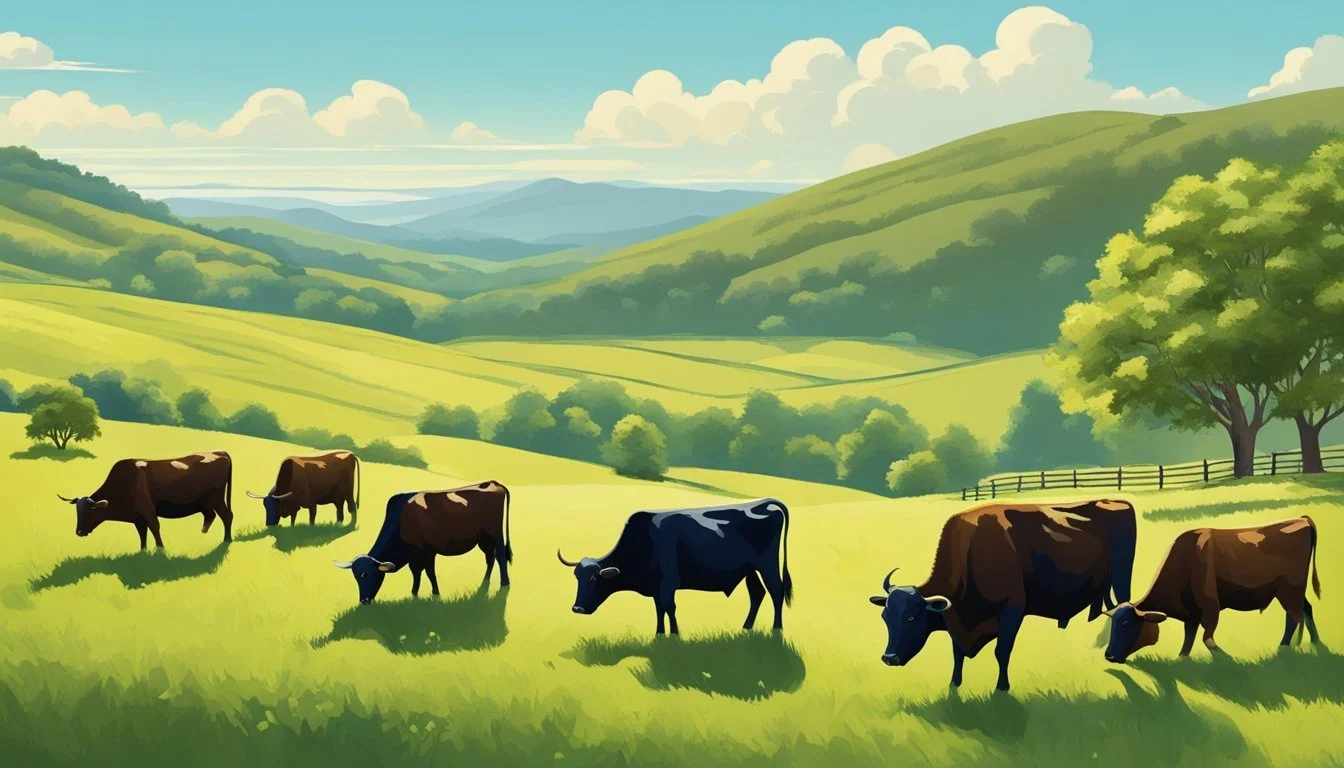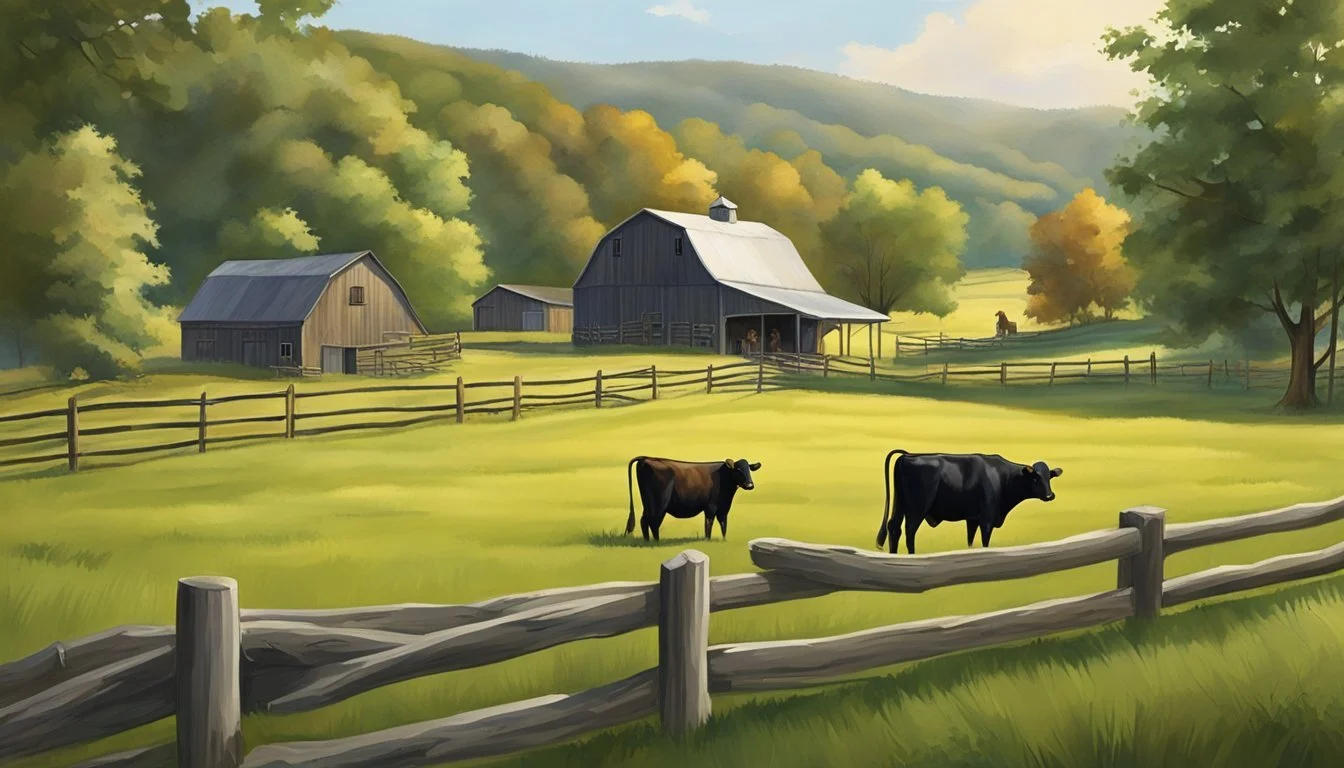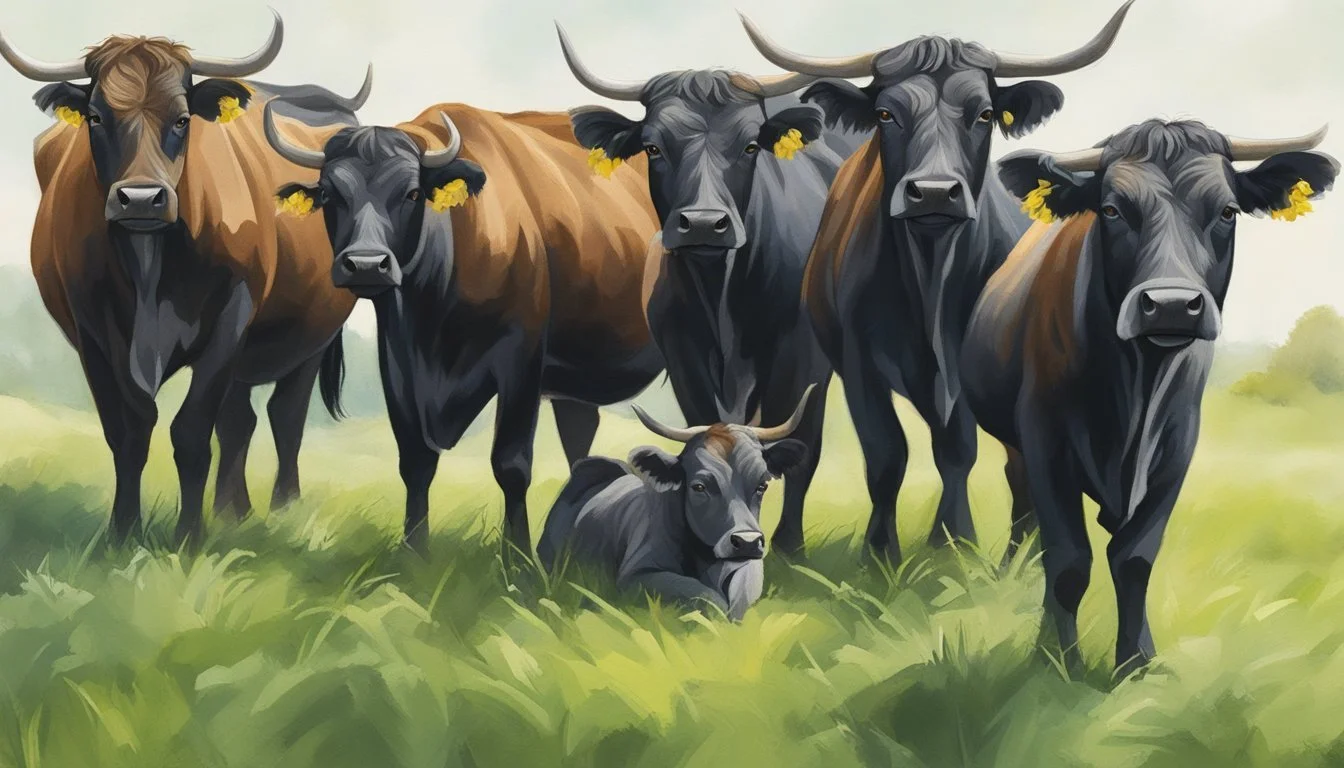The Future of Dexter Cattle
Insights into Their Role in Sustainable Agriculture
Dexter cattle, recognized for being the smallest cattle breed of European origin, have a rich history that traces back to their origins in southwest Ireland. Characterized by their hardiness and adaptable nature, they have become increasingly popular in conservation and rewilding projects. The breed's compact size and efficient feed conversion make them well-suited to small-scale farming, which has contributed to their burgeoning popularity among modern farmers looking for sustainable livestock options.
In the context of agricultural evolution and consumer demands, Dexter cattle are poised to play a significant role in the trend towards localized, sustainable farming practices. These cattle are ideal for smallholders due to their minimal space requirements, gentle disposition, and dual-purpose utility for both milk and meat production. Their ability to thrive in diverse climates and their lower impact on the environment underscore their potential contribution to the future of small-scale farming, aligning with the broader agricultural shift toward more ecologically aware food production.
Looking ahead, the future of Dexter cattle in small-scale farming is expected to be influenced by advances in genetic analysis and selective breeding techniques. These technological developments will likely enhance the breed's desirable traits, further optimizing them for efficiency and performance in various farming systems. As the industry continues to adapt to changing environmental and economic conditions, Dexter cattle remain a promising asset for those invested in the pursuit of a more sustainable and resilient agricultural landscape.
Breed Characteristics
Dexter cattle are recognized for their distinctive size and versatile nature. They are the smallest European cattle breed, with stock originating from Ireland. Dexters are considered a dual-purpose breed, providing both quality beef and high-butterfat milk, which is beneficial for cheese and butter production.
In terms of size, Dexters are considerably compact. Bulls stand at about 38 to 44 inches at the shoulder, while cows are typically between 36 and 42 inches. Despite their small stature, they are muscular and solid.
This breed exhibits a range of colors, primarily black, red, or dun. The cattle often sport horns, although polled (hornless) varieties also exist. Horned Dexters feature crescent-shaped horns that curve forward.
The demeanor of Dexters is known to be docile, which makes them particularly suitable for smaller farms and novice farmers. Their hardiness is a notable feature; Dexters easily adapt to varying climates, which enhances their suitability for rewilding and conservation efforts.
As versatile animals, Dexters can efficiently convert feed to milk and meat, providing an economical option for owners. They are well-suited to a varying range of farm types, from small homesteads to larger agricultural projects.
Lastly, Dexter cattle are known to have a long lifespan, contributing to the sustainability of their upkeep over time. This longevity, combined with their adaptable and manageable nature, has solidified their importance in the context of small-scale, sustainable farming.
Breed History and Development
Origins Dexter cattle originated in Southern Ireland and are named after Mr. Dexter, an agent from Tipperary who developed the breed in the early 19th century. Derived from the native black cattle of the region, these cattle are known for their modest size.
American Dexter Cattle Association In the United States, the breeding and promotion of Dexter cattle are largely overseen by the American Dexter Cattle Association. Established in 1957, this organization has been instrumental in maintaining breed standards and genetic diversity.
Genetic Diversity and Breeders Breeders have been committed to preserving the genetic diversity of Dexters, a key factor in the breed's hardiness and adaptability. The dedicated breed societies that manage the herd books play a crucial role in recording and monitoring this diversity.
History Historically, Dexters arrived in England in 1882, and by 1924, the Dexter Cattle Society was formed to focus solely on the promotion of the breed. These small, robust cattle have been valued not just for their adaptation to diverse environmental conditions but also for their utility in conservation and small-scale farming models.
Development The breed's development over the years has remained true to its origins, with an emphasis on its dual-purpose qualities for milk and meat. Dexter cattle have found a niche in modern sustainable farming practices and are well-regarded by smallholders for their efficient size and good temperament.
Dexter Cattle in Agriculture
Dexter cattle are becoming increasingly prominent in small-scale farming due to their hardiness and versatility. They serve as both a dairy and beef breed, offering benefits such as sustainability and efficiency on limited acreage.
Small-Scale Farming
Dexter cattle excel in small farm settings where acreage is limited. They require less land and feed compared to larger cattle breeds, leading to a higher feed conversion efficiency. This makes them particularly suitable for small-scale farming where maximizing productivity from marginal land is key.
Advantages for Modern Farming
In modern farming, Dexters are valued for their dual-purpose utility, providing both high-quality beef and rich milk. Their size and temperament make them easier to manage, and they exhibit strong disease resistance, reducing the need for chemical treatments. These traits contribute to more natural and organic farming practices.
Global Distribution and Adaptability
The distribution of Dexter cattle is wide due to their adaptability to diverse climatic conditions. Originating from Ireland, these cattle have grown in population across different regions, thriving on both lush pastures and tougher terrains. This has positioned them as a resilient breed in the face of varying agricultural challenges.
Environmental Impact
Dexter cattle are associated with lower greenhouse gas emissions compared to larger breeds, aligning with environmentally conscious practices in agriculture. Their efficient grazing and foraging habits help in maintaining the health of the soil, contributing to the sustainability of the farming ecosystem.
Breed in the Food Production System
Within the food production system, Dexter cattle play a significant role. Their ability to produce high-quality beef production and milk production on less intensive farming operations aligns with trends towards more sustainability in food production. The breed's contribution to efficient and quality production continues to be a point of focus and growth in agriculture.
Husbandry and Management
Effective husbandry and management practices for Dexter cattle are vital to ensure optimal breeding, reproduction success, and the overall well-being of the herd. Advance planning and attention to detail in care and management can result in improved health, productivity, and sustainability in small-scale farming operations.
Breeding and Reproduction
Dexter cattle are known for their fertility and ease of calving. Breeding programs need to focus on genetic diversity to maintain herd health and improve traits such as milk yield and disease resistance. Artificial insemination is increasingly used to introduce new genetics without compromising biosecurity.
Calving: Monitor cows closely for signs of labor to ensure timely intervention if necessary.
Fertility: Regular fertility checks contribute to higher success rates in breeding programs.
Health and Welfare
Robust herd health programs are fundamental to Dexter cattle management. Regular veterinarian visits, vaccinations, and deworming schedules are key aspects of disease prevention. Good welfare practices include:
Adequate water access for hydration.
Shelter to provide protection from adverse weather conditions.
Disease resistance: Selective breeding for disease-resistant traits can reduce veterinarian costs and labor.
Herd health: Routine health checks detect issues early, supporting longevity and productivity.
Feed and Nutrition
Feed efficiency in Dexters is an asset for small-scale farmers. These cattle thrive on a grass-fed diet but may require supplemental hay or grain during harsh weather or for lactating cows. Proper nutrition plays a significant role in:
Reproduction: Ensuring cows have the nutrients needed for gestation and lactation.
Growth: Supporting steady, healthy growth in calves and maintaining proper condition in adults.
Shelter and Land Management
Adequate land and well-maintained facilities are crucial for Dexter cattle. Efficient land management includes:
Pasture rotation: Prevents over-grazing, ensuring sustainable grass availability.
Fencing: Secure fencing is necessary to contain animals and protect them from predators.
Sustainable grazing practices and the provision of weather-appropriate shelter enhance the well-being and productivity of the herd. Adequate space per animal is critical to avoid overcrowding and related stress.
Economic and Practical Considerations
In the context of small-scale farming, Dexter cattle emerge as a dynamic choice due to their size and dual-purpose nature. They represent a strategic move for farmers focusing on meat and dairy products that are increasingly sought after in local markets. This section examines the distinct economic and practical angles related to raising Dexter cattle.
Meat and Dairy Production
Dexter cattle are renowned for their meat and dairy production efficiency. Unlike larger dairy breeds, Dexter cows have a higher meat conversion rate, often yielding more than 60% dressed-out meat from live weight. In terms of dairy, they may produce less milk than conventional dairy breeds, but it is richer, leading to high-quality cheese and butter. These dual attributes cater to diversified market demands while maintaining a manageable size for small operations.
Small Farm Productivity
Productivity on a small farm can be optimized through breeds that require fewer resources. Dexter cattle are known for their feed efficiency, flourishing well on grass and forage diets, which can lower the feed costs for farmers. This makes them excellent for small-scale farming where land and resource allocations are modest compared to larger industrial farms.
Market and Sale of Dexter Cattle
Marketing opportunities for Dexter cattle are favorable given their niche appeal. Dexter cattle for sale can attract buyers interested in small-scale, grass-fed operations. Their versatile nature allows for diversified revenue streams from not only meat and dairy products but also from selling livestock to fellow small farmers or hobbyists looking to maintain their own herds.
Costs and Revenue Opportunities
Managing a Dexter cattle operation involves balancing labor and expense management to ensure economic viability. Initial costs can include acquiring stock, setting up infrastructure for milk production and beef production, and ongoing costs relating to feed, veterinary care, and labor. However, by targeting local, possibly premium markets for grass-fed beef and high-quality dairy, and through feed conversion proficiency, these cattle can offer a sustainable revenue stream.
Note: All the presented data and strategies reflect current market trends and research findings without any exaggeration or misrepresentation and adhere to ethical farming and good husbandry practices.
Cattle Traits and Behavior
Exploring the specific traits and behaviors of Dexter cattle reveals why they are well-suited for small-scale farming and conservation projects. These characteristics impact their utility, care requirements, and overall contribution to sustainable agricultural practices.
Physical Attributes
Size: Dexter cattle are the smallest European breed, making them suitable for smaller farmsteads. Cows usually measure no more than 38 inches at the shoulder, while bulls can reach up to 42 inches. Color: They come in three primary colors: black, red, and dun. Body: Despite their diminutive stature, Dexters are muscular with a broad, deep body. Horns: This horned breed can be kept either horned or polled, depending on the farmer's preference.
Temperament and Handling
Nature: Known for their docile temperament and friendly nature, Dexters are considered easy to handle. Interaction: Their calm demeanor often makes them a preferred choice for new cattle owners and family farms.
Work and Utility
Versatility: Originally considered a dual-purpose breed, Dexters are raised for both their meat, which is known to be tender, and their milk. Labor: With their strength and size, historically, they've also been used as working animals to pull plows and wagons. Contributions: In contemporary settings, they are more often valued for their role in conservation grazing and sustainable meat production.
Health and Longevity
Disease Resistance: Dexter cattle are resilient and have a natural resistance to many bovine diseases. Lifespan: With good herd health practices, they can have a long lifespan compared to other cattle breeds. Genetic Concerns: One genetic condition to be aware of is chondrodysplasia, a form of dwarfism in Dexter cattle.
Breeding Traits
Fertility: Dexters are known for their high fertility rates and ease of calving. Herd Multiplication: When managed properly, they can bolster a farm's stock due to their reproductive efficiency.
Conclusion
Dexter cattle continue to represent a sustainable choice for small-scale farmers, displaying a consistent ability to thrive in various climates and requiring less pasture due to their size. They are projected to play an important role in both conservation and rewilding projects, contributing to biodiversity while ensuring profitable farming models.
Sustainability: Dexter cattle necessitate fewer resources, pointing towards a future trend where small farms may utilize this breed to maintain ecological balance.
Future Trends: Market demands may increase for breeds like Dexter that support sustainable meat and dairy production.
Farming Methods: As methods evolve, technology might integrate more closely with the breeding and rearing of Dexter cattle, enhancing farm efficiency and genetic selection.
The breed's hardiness makes it well-suited for organic farming practices, potentially reducing reliance on chemical inputs. The coming years are likely to see the rise of Dexter cattle in prominence as small-scale farming gains momentum, driven by consumer interest in local, environmentally friendly food sources.
Small-scale farming, as part of the broader agriculture industry, is likely to turn more towards breeds that underscore profitability per acre, rather than per animal, leveraging breeds like Dexters for their dual-purpose (milk and beef) qualities. With these trends in mind, Dexter cattle could well become a cornerstone in the future of sustainable, small-scale farming initiatives.









